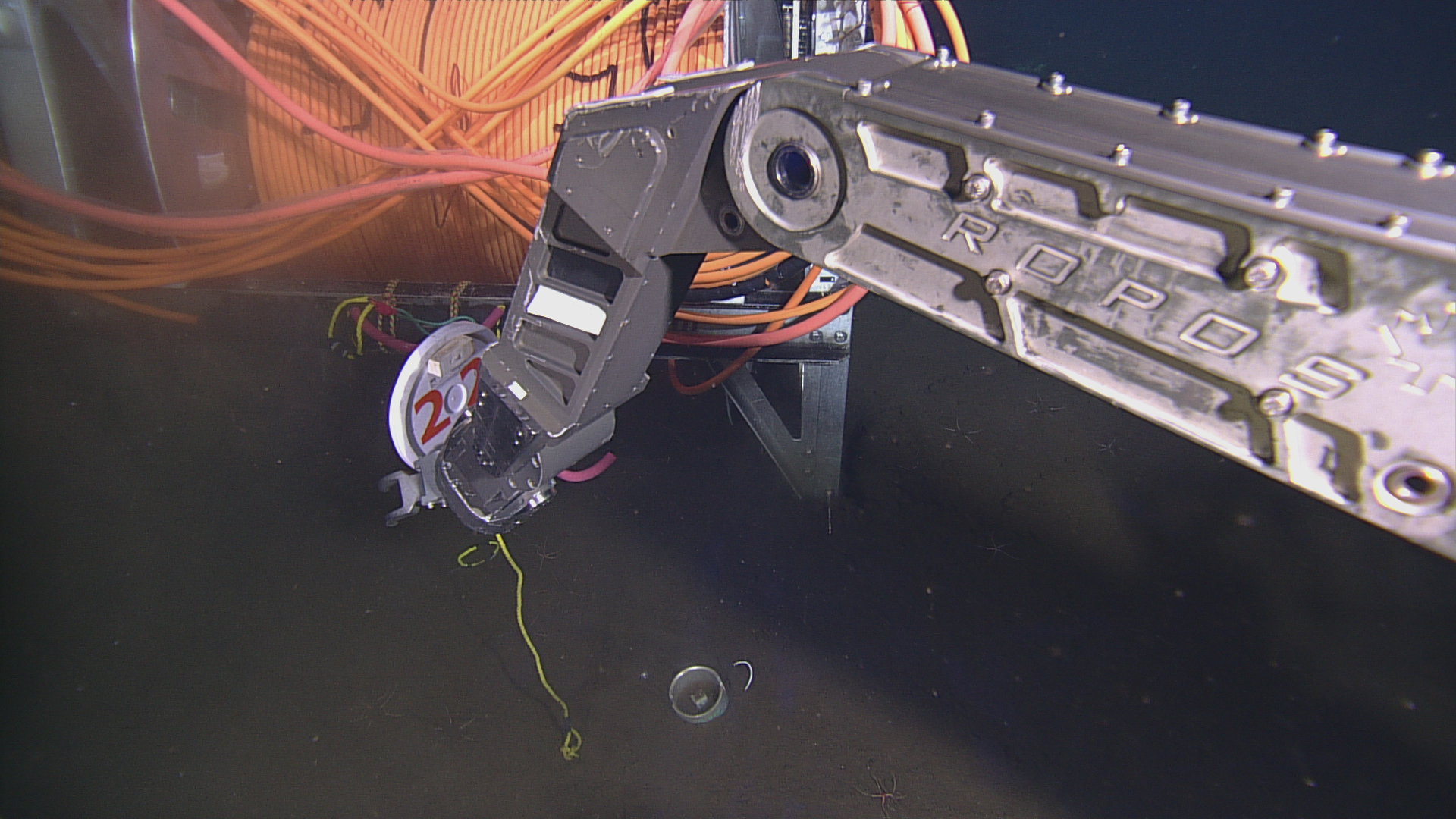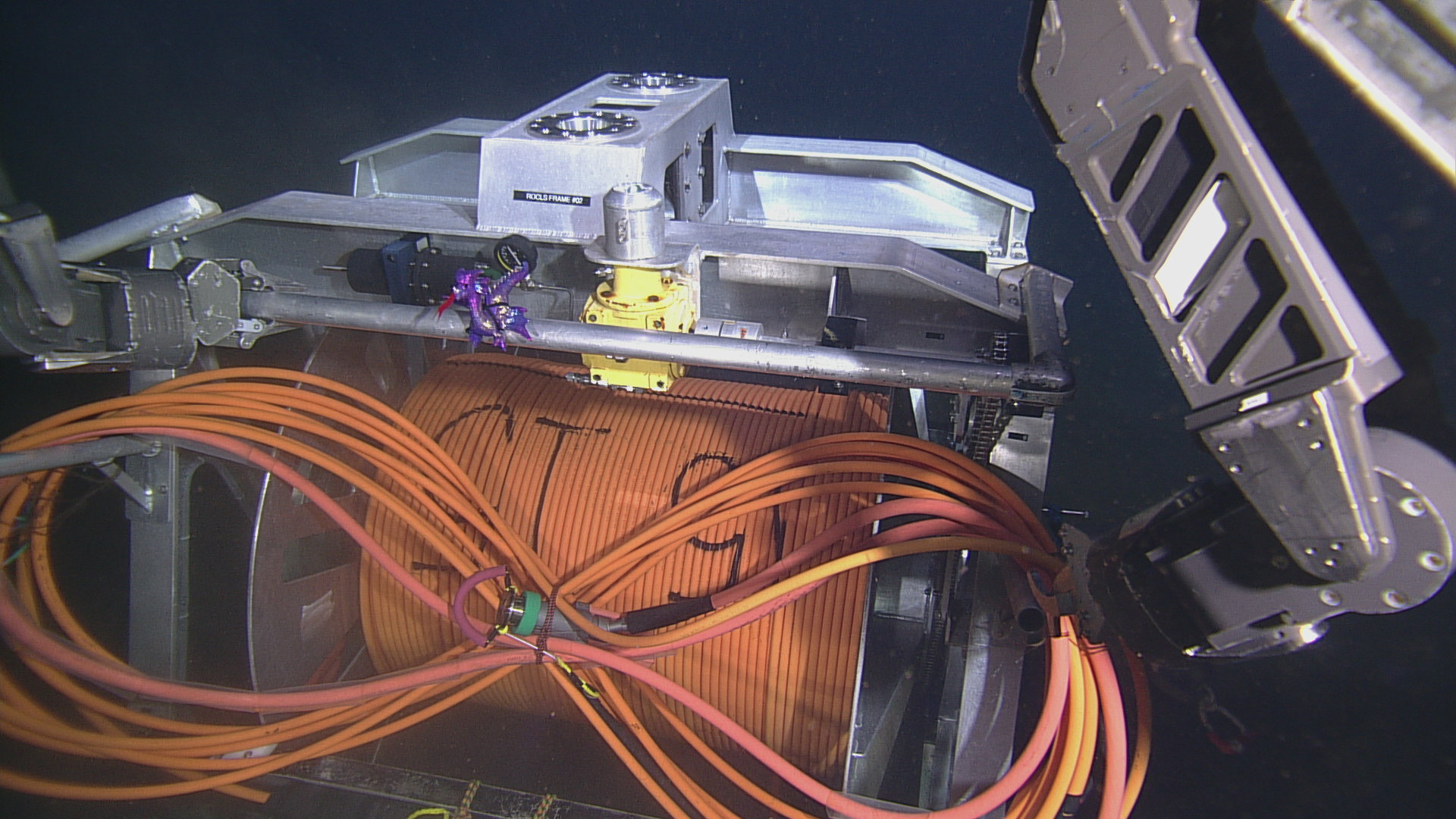Image Archive






















Removing Marker #22 from the seafloor at Axial Base, prior to laying cable AXVMW4. Photo Credit: NSF-OOI/UW/CSSF, Dive 1737, V14

ROPOS removing the bungee cords holding the slack cable of AXVMW4 onto the ROCLS sled. Photo Credit: NSF-OOI/UW/CSSF, Dive 1737, V14

The port arm of ROPOS reaching for the connector in a flange box on the seafloor at the Slope Base site. Photo Credit: NSF-OOI/UW/CSSF; Dive 1734; V14.

The port arm of ROPOS seating the plug connector of RS01W6 to J1 on Low Voltage node LV01A at the Slope Base site. Photo Credit: NSF-OOI/UW/CSSF; Dive 1734; V14.

A larvacean (the small, white, peanut-shaped object) inside its mucus house, feeding on marine snow at 700m depth at the Slope Base Site. Photo Credit: NSF-OOI/UW/CSSF; Dive R1733; V14

Keith Shepherd, ROPOS Operations Manager, and ROPOS Pilot Kim Wallace, guide the R/V Thompson into position to deploy the ROCLS drum onto the seafloor at 5000 ft water depth to begin installation of the 4.6 km extension cable. ROPOS later will latch into the ROCLS drum and begin the cable lay. Photo credit: Mitch Elend, University of Washington, V14.

Meet the star of the VISIONS '14 movie, the robotic vehicle ROPOS - powerhouse of the operations during VISIONS 14. Photo credit: Christina Ramirez, University of Washington, V14.

The ROV ROPOS has an RSN-OOI , medium-powered junction box, MJ03C, secured to its underbelly for transport to the International District hydrothermal vent field. The junction box will provide power and communication to a diverse suite of chemical, temperature, and biological sensors, in addition to a digital still camera. Photo credit: NSF-OOI/UW/CSSF; Dive R1717; V14.

ROPOS uses a T-handle to latch into the top of the ROCLS cable drum. Photo Credit: NSF-OOI/UW/CSSF; Dive R1716; V14.

The ROV ROPOS is one of only a very few robotic vehicles that can install extension cables deep beneath the ocean's surface. Here, numerous screens provide updates on the postion of the R/V Thompson 8500 feet above the vehicle, the location of ROPOS, and cable lay information. This image was taken during Dive R1715, installation of the first cable on the VISIONS '14 expedition. Photo Credit: Mitch Elend, University of Washington; V14.

The Canadian ROV ROPOS is latched into the ROCLS cable laying system, taking a 1 km-long extension cable down to the seafloor at the base of Axial Seamount. Photo Credit: Mitch Elend, University of Washington, V14.

Keith Shepherd, Operations Manager for the Canadian Scientific Submersible Facility, oversees the lauch of ROPOS for Dive R1713. Photo Credit: Mitch Elend, University of Washington; V14.

On a beautiful sunny day, the ROV ROPOS is launched from the R/ V Thompson. Photo credit: Mitch Elend, University of Washington; V14.

The remotely operated vehicle (ROV) ROPOS begins its first science dive at Axial Seamount of VISIONS'14. An empty junction box is attached beneath the ROV's 'belly'. Photo Credit: Mitch Elend, University of Washington, V14.

On the transit out to Axial Volcano, a short stop was made to conduct a "Dunk Test" with the ROV ROPOS to ensure all was ready to go upon arrival at Axial Seamount. Image Credit: Mitch Elend, University of Washington, V14.

The ROV team, SN scientists and engineers, and UW students gather in the operations laboratory aboard the R/V Thompson during Dive 1605 to Southern Hydrate Ridge during the VISIONS'13 Expedition. Photo Credit. Mitch Elend, University of Washington.

With ROPOS's heavy lift capabilities and industry style latch system on its underbelly, it is able to safely take heavy loads to the seafloor. During the VISIONS'13 Expedition, ROPOS takes two short-period seismometers to the seafloor in the tool basket at the start of Dive 1617 to the caldera of Axial Seamount.

During the UW-OOI-NSF VISIONS'13 Expedition, the remotely operated vehicle ROPOS installed three medium power J-Boxes (secondary nodes) utilizing their special 4,000 lb heavy lift capabilities. ROPOS took this RSN J-Box down on dive R1601. The broad feet on the J-Box are used for installation in heavily sedimented areas. This was an unusually calm day at sea in the NE Pacific. Photo Credit: Mitch Elend, University of Washington.

ROPOS decends to the seafloor during the VISIONS'13 expedition. Photo Credit: Mitch Elend, University of Washington

ROPOS enters the Pacific with a medium powered junction box attached to its underbelly. Photo by Marisa Gedney

The remotely operated vehicle ROPOS dives into the darkness during the VISIONS'11 expedition.
- Anemone
- Animal
- Arthropod
- ASHES
- Axial
- Axial Base
- Axial Biology
- Axial Caldera
- Bacteria
- Basalt Lava
- BEP
- Biofouling
- biolgoy
- Biology
- Camds
- Camera
- Camhd
- Central Caldera
- Ciliates
- Cnidaria
- Coastal Biology
- Crab
- Deep Profiler Mooring
- Dive Highlights
- Eastern Caldera
- Echinoderms
- Endurance Array
- Engineering Team
- ENLIGHTEN 10
- Exploratorium
- Fish
- Geology
- HD Camera
- HPIES
- Hydrate Ridge
- Hydrates
- Hydrophone
- Hydrothermal Vents
- Illustration
- Inshore 80 Meters
- Instrument
- International District
- J-BOX
- Jason
- Jellyfish
- Junction Box
- K12
- Lava
- Mollusk
- Moorings
- Nodes
- Nudibranch
- Octopus
- OOI
- Oregon Offshore
- Oregon Offshore 600 m
- Oregon Shelf
- Oregon Slope Base
- People
- PN1B
- PN1D
- Polychaetes
- PPSDN
- Primary Node
- RASFL
- ROCLS
- ROPOS
- ROPOS Dives
- ROV Team
- RV Revelle
- RV Sikuliaq
- RV Thompson
- Salp
- Sample
- SC13
- Science Team
- Sea Cucumber
- Sea Star
- Sea Urchin
- Seafloor
- Seismometer
- Sensors
- Shallow Profiler Mooring
- Shark
- Shipboard
- Shore Station
- Slope Base
- Smoker
- Soft Coral
- Southern Hydrate Ridge
- Sponge
- Squid
- Students
- Students & Guest Participants
- Tmpsf
- Tubeworms
- VISIONS 11 Leg 1
- VISIONS 11 Leg 2
- VISIONS 11 Viewers
- VISIONS 13
- VISIONS 14
- VISIONS 15
- VISIONS 16
- VISIONS 17
- VISIONS 18
- VISIONS 20
- VISIONS 22
- VISIONS 23
- Visualization
